3/1/2020
Start Clean. Stay Clean.
Bill Calkins
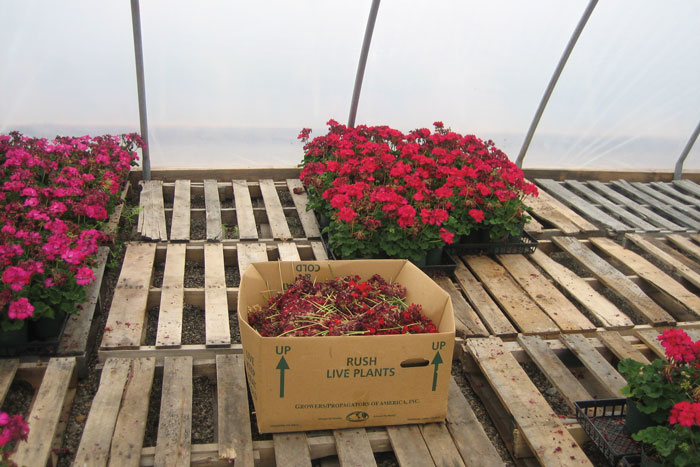
Every greenhouse in the world has its hot spots—areas where insect and disease pressures seem to be the worst from year to year. You probably know where they are, and warn your growers and team members to stay on red alert. Maybe that’s a particular house or corner of a production zone or perhaps it’s a certain time of year or a certain crop. But do you have processes in place year-round, and even daily, to help prevent the spread of pests and diseases? You need to and it’s going to take a team effort.
Pictured: When remnants from plant cleanup aren’t covered and removed from the greenhouse, they become a breeding ground for disease.
Dr. Todd Cavins, technical services specialist at Ball Horticultural Company, believes greenhouses of all sizes need an organized, systematic approach to sanitation, especially in high-pressure times like spring.
“Get robotic about it,” he says. “Make it boring.” Every day, it should be part of the system.
The good thing is that simple cleaning requires little time and labor, and results in major gains in terms of reduction in plant loss.
In this article, we’ll look at greenhouse sanitation best practices, as well as activities and methods that will help you stay on top of cleanliness. Sanitation is a concern that touches every aspect of greenhouse production, so be sure to share this one with your entire team.
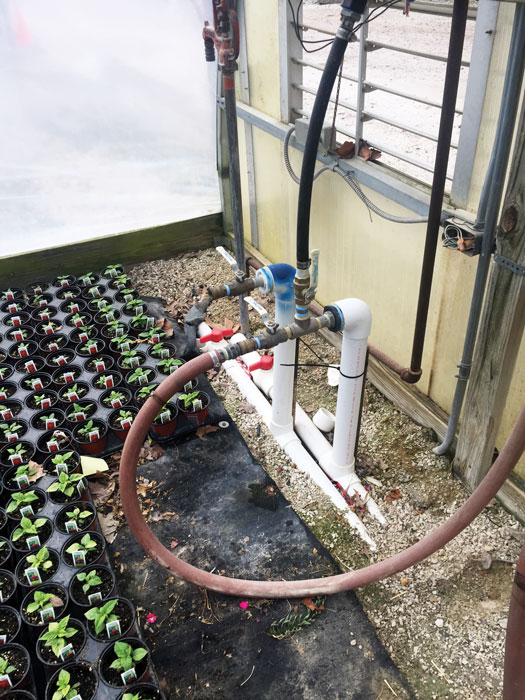
Common problems
The goal for every greenhouse is to produce good, healthy plants and for this to happen, sanitation protocols must stay top of mind. Pests and diseases can be transmitted in many ways, and Ball Seed’s greenhouse technical team has seen just about everything. Todd says one of the most common challenges he sees can often begin at the top—with greenhouse managers and head growers.
“We often see managers transmitting diseases simply because they spend their days walking greenhouse to greenhouse observing crops,” he explains. “Protocols are necessary between houses. Often, it’s us, not the pest, moving around.”
Pictured: Vents and doors are hot spots for sanitation issues. Clean up debris on the ground and remove weeds that can wreak havoc on your crop.
Other common problems arise when trash isn’t cleaned up in a timely fashion. You see it, but often walk past—that pile of cuttings, removed flower buds and plant matter left from pinching. That overflowing trash can by the door of the greenhouse. The pile of debris that was swept up, but not disposed of correctly. Take a minute to walk around your facility with eyes peeled and I can almost guarantee you’ll find plant matter piled up somewhere. We’re not trying to point fingers, but merely to open your eyes to issues that lead to pests and diseases.
Kurt Becker, executive vice president at Dramm Corporation, says pathogens are a large problem for most growers.
“Crop failures often result, causing economic damage,” he explains. “These can be exacerbated if growers are shipping product to other growers, which can also cause liability issues.”
Todd tells a story of a trip to a greenhouse in the past when he encountered a significant spider mite population on hanging baskets of ipomoea … in December. Being winter, it was an odd challenge to solve. He and the owner spent time tracking down the cause and eventually traced the issue to dirty pallets on the floor of the greenhouse where the baskets were placed after sticking, before they were hung up.
“The pallets were filled with debris,” he says. “It was a pest problem from the previous year that overwintered in debris.” We often concentrate too much on the plants, when the problem is often with the facilities or the people, Todd adds.
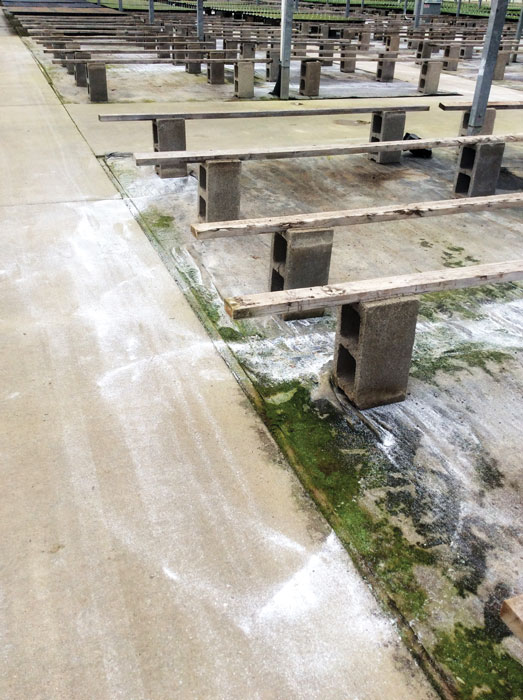
Where to begin
Speaking of people, a good place to start implementing sanitation protocols is wherever production is consolidated. Todd recommends beginning in common areas like transplant lines, propagation areas and anywhere multiple people tend to congregate in close proximity with plants.
“Start here with sanitation of people and tools,” he says. This needs to become a part of your company culture—running a clean operation. Todd also recommends checking openings to make sure there are good seals so pests can’t sneak in and out. “Vents and doorways can be hot spots,” he says.
Pictured: Applying cleaning agents between crops saves time, money and reduces pesticide use. A granular algaecide is quick to apply and will eliminate many problems quickly.
After seeking out the hot spots, begin implementing basic protocols to limit insect and disease transfer between houses or zones. Limiting human traffic can be very effective. It could be as simple as defining paths your team should take through the facility. Todd suggests roping off specific areas and reminding growers and staff to follow the path and not sneak through benches to get from house to house.
And when workers do go from house to house, consider requiring clothing changes and regular glove cleaning. Some of the large propagation greenhouses actually have alarms that go off throughout the day to remind staff to disinfect gloves and tools.
“Sanitation is a year-round, day in and day out constant process. It should never stop,” said Todd.
Additional sanitation suggestions
There are many approaches you can take, structurally, to reduce pest and disease threats. We already mentioned checking seals on vents and doors, but have you considered plastic barriers between bays and zones? Todd says thin plastic walls that extend a few feet above benches can stop insect movement and even prevent water splashing from crop to crop, which can reduce disease spread. And if you add sticky tape to these barriers, the effectiveness goes up, slowing insect travel and allowing you to monitor better.
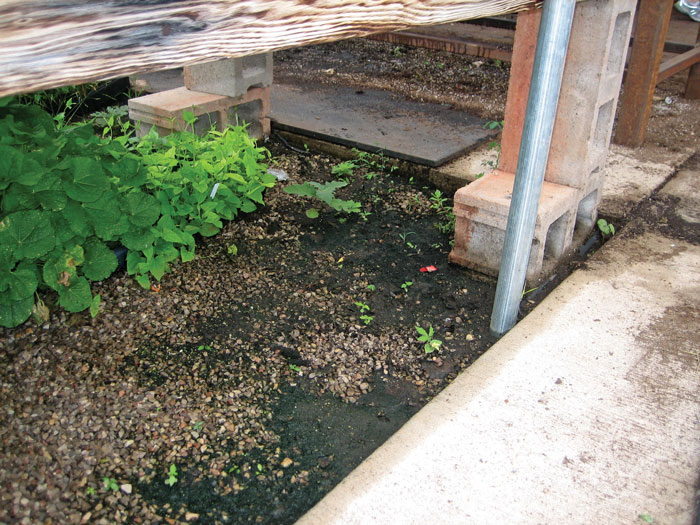 There’s no lack of chemicals for disinfecting and disinfesting, and we won’t go into too much detail here, but let’s talk basics. First, Todd reminds that you should always clean before disinfecting—this means picking up debris and employing many of the strategies we’ve already touched on. Next, consider using acidified soaps to deep clean benches and floors.
There’s no lack of chemicals for disinfecting and disinfesting, and we won’t go into too much detail here, but let’s talk basics. First, Todd reminds that you should always clean before disinfecting—this means picking up debris and employing many of the strategies we’ve already touched on. Next, consider using acidified soaps to deep clean benches and floors.
Pictured: Bare ground, weeds and algae are common in greenhouses. Unfortunately, they’re hosts for greenhouse pests like thrips and fungus gnats, which can vector disease.
“These will break down waxy coatings and minerals that harbor disease,” Todd says. “Then rinse thoroughly and begin disinfecting.” Always follow label instructions because these products are acidic and can be
corrosive.
Common disinfectants include oxidizers and quaternary ammonium products. The newer chemicals tend to have better longevity and are more stable than in the past. Talk to your suppliers to determine the best products for your operation and specific needs.
Application options
Application techniques are also important to consider. For example, if you’re disinfecting porous surfaces where cleaners might rinse away or run through, foaming applicators might be your best bet to increase contact time and effectiveness. Kurt agrees, explaining the application of sanitation products is important to their success.
“Disinfectants work better with longer contact time,” he says. “Methods of application that increase contact time increase the ability for these disinfectants to work.” He goes on to say thick foam is a good way to increase this contact time and drier foams not only persist longer, but also adhere to vertical surfaces and don’t run off as quickly. As a result, less disinfectant is often required because foam stays where it’s intended.
Going into greater detail, Kurt explains foam quality can vary depending on how foam is produced.
“Hose-end foamers produce a foam by siphoning chemical solution and mixing with atmospheric pressure air,” he says. “This produces poor quality foam that does not persist.”
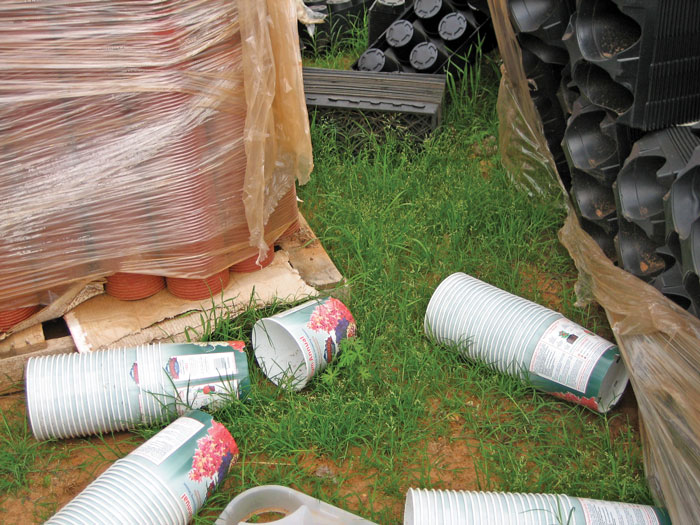 Pictured: Clean storage of pots and trays reduces pest and disease pressure. Containers like these can now move pests and disease from the weeds to the flowers.
Pictured: Clean storage of pots and trays reduces pest and disease pressure. Containers like these can now move pests and disease from the weeds to the flowers.
The better approach is foam produced using compressed air, resulting in drier foam because air can be injected to create expansion of the liquid. Hand-compression foamers using compressed air produce much higher quality foam, he says.
Final words
Even after you’ve cleaned and disinfected, continue your sanitation protocols through the season. Todd suggests cleaning benches, removing debris and sanitizing as often as possible between turns, or after you empty benches and clear floors.
“Some growers spread oxidizer granules under benches using a spreader during the season,” he says. “This helps eliminate algae.” Just be sure to follow instructions to eliminate the danger of burning your crop.
Kurt warns it’s hard to disinfect when plants are in the greenhouse. “Not only can plants be harmed, the application takes longer because plants are in the way and it is harder to clean up,” he explains. “Starting clean prevents more problems that often require multiple applications of fungicides and sometimes the Dumpster.” An ounce of prevention is worth a pound of cure.
No matter when you’re reading this article, there’s something you can do right now to reduce pest and disease threats. And it’s also a good time to start processes in your business to establish protocols for your entire team to follow. Don’t let an outbreak of insects or major disease crisis be the catalyst for improvement. Clean up, check your structures, look up and down and you’ll no doubt see potential problems. Keep at it and you’ll soon see improvement in the health of your crops. GT